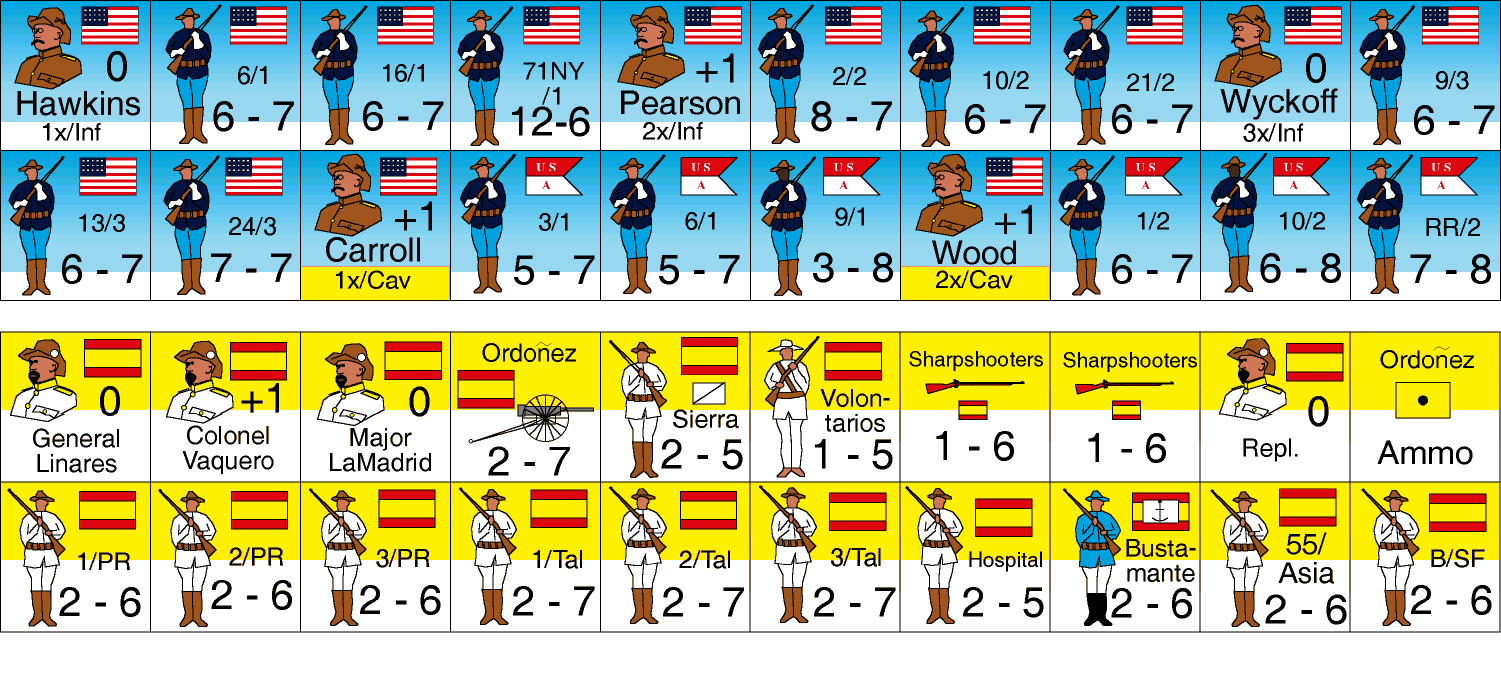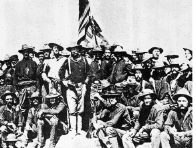|
|
|
|
Rough Riders A tactical simulation of the Battle for San Juan Hill, fought on July 1, 1898 during the Spanish-American War. It was the largest land battle fought during the war, and the American victory would propel Teddy Roosevelt towards the White House. The battle was not as one-sided as most Americans think, as Spanish troops fought with bravery and grim determination, and inflicted 3 times their own casualties on the American forces. The basic units in the game are regiments of infantry and dismounted cavalry for the Americans, companies and battalions for the Spanish, and batteries of artillery for both sides. The scale is 125 yards per hex, with 45 minutes per turn, and roughly 60 to 75 men per strength point. Ranged fire, assaults, morale, leader casualties, step reduction, Gatling Guns, sharpshooters, the observation balloon, journalists, trenches, and the Sims-Dudley dynamite gun are all covered. Two scenarios, one covering the historical fight and one a "what-if." Solitaire rules included. $14.00
|
|

|

|

|
|
|
Historical notes (from the rulesbook) After diving into the research for this game, I discovered why no one had done it before. While there is very complete information on the strength and composition of American forces, the lack of solid information on the Spanish side was puzzling. The fact is that few English language accounts attempted to learn what the Spanish had atop the heights, how they were armed, or what their battle plan had been.
Every American schoolboy has read about the charge up San Juan Hill, and how Teddy and the Rough Riders put the Spanish to flight. The reality was, of course, quite different. Background When the war broke out, the American army was not prepared in any way, shape, or form. The regular army numbered less than 28,000 men, while Spain had sent over 150,000 men to the Caribbean (in part to suppress the Cuban insurrection). The American army was (once again) forced to rely on volunteer formations with little formal training and armed with aging equipment. The regular army formations of the US Army were armed with breech loading Krag-Jorgensen rifles, while the volunteers were given outdated Springfields. The Springfields were breech loading, but used black powder, which, according to one private, gave off "a cloud of smoke the size of a cow" when fired. The same problem faced the artillery, which used old field pieces that belched clouds of smoke when fired, making it easy for the enemy to spot their position. In contrast, the Spanish regulars were fairly well trained and most were armed with the latest German-made Mauser rifles, which fired smokeless powder and had excellent accuracy and range. Likewise, the Spanish artillery fielded German-made Krupp pieces that also left no tell-tale smoke trail when fired. The locally recruited Cubans were armed with an assortment of outdated Remingtons and other small arms, like Argentine knock-off Mausers and machetes. The Spanish were, in general, more acclimated to the heat, humidity, malaria, and other niceties of the Cuban jungles. The Rough Riders (mostly cowboys and ranch hands from Arizona, New Mexico, Texas, and Oklahoma) were only one of the colorful units on the US side. The 9th and 10th US Cavalry units were made up of the famed "Buffalo Soldiers" - Black Americans with experience on the frontier. The US force that was committed against San Juan Hill was led by General Joe Wheeler, a former Confederate cavalry general (I assume that everyone can see the irony here). Wheeler was advanced in years (after all, this was 33 years after the American Civil War had ended), and spent most of the battle sick in bed. The Plans The US forces landed on the southern coast of Cuba at Daiquiri and Siboney. The plan was to march along the jungle roads to the northwest, and lay siege to the city of Santiago. The US force split into two parts, with half moving towards El Caney and half moving towards San Juan Hill (El Caney is north of the map area, on the road from Marianage). The US force took El Caney after an all-day battle with the 500 Spanish entrenched there. The force selected to take San Juan Hill began July 1 encamped in and just east of the ruined El Pozo sugar plantation. The orders issued to the division and brigade commanders were very broad, directing them to advance towards Santiago along the main road. Scouts reported that San Juan Hill was not held in any strength. General Wheeler was ill, and the US forces lacked overall direction for most of the day. Before July 1, the heights of San Juan were hardly held by the Spanish forces. General Linares had almost 13,000 men in and around Santiago, but that number was deceiving. Most of these were not capable of field maneuvers, being used primarily to hold blockhouses and other fortified positions against the Cuban insurgents. Most were deployed facing the Cuban insurgent army of General Calixto Garc’a, to the northwest of Santiago. Linares had only about 4500 men on the eastern side of Santiago, and these were spread out defending in a broad semi-circle along the heights overlooking the city. San Juan Hill was held only by a delaying force, as was El Caney. The San Juan heights were lower than the main Spanish defensive line near Fort Ca–osa, and fire from the fort could easily sweep over the hill. San Juan Hill could also be easily flanked on both north and south, and holding it in force only invited encirclement. Linares was therefore prepared only to fight a delaying action on July 1, and awaited the arrival of Col. Federico Escario and his column marching from Manzanillo towards Santiago. This force arrived 2 days after the battle, and the siege began in earnest. Had this force arrived prior to July 1, it would have given Linares a mobile field force with which to contest the US advance (this option can be explored in the second scenario). The Battle The American forces ordered to advance on San Juan Hill were part of the V Corps, consisting of an infantry division and a cavalry division. The cavalry division would move and fight dismounted, as the horses had not weathered the voyage from Tampa well. It didn't help that "unloading" the horses from the transport ships consisted of driving them overboard and letting them swim ashore! The US force numbered around 8,000 men, and was ordered up the road without detailed plans or briefings for any of the unit commanders. The Spanish reinforced the Heights that morning, and held reserves near the crossroads at Fort Ca–osa. Grimes Battery opened fire at long range, from the hill overlooking El Pozo. The gunners could not see the Spanish line atop San Juan Hill, and fired blindly. The Spanish gunners under Ordo–ez returned the fire with their Krupp field pieces, and zeroed in quickly on Grimes because of the telltale smoke from the black powder. The Spanish fire scattered the Cubans, and caused many casualties among the cavalry massing along the road. The US regiments pushed up the main road, harassed by sharpshooters. The regiments halted near the ford, which became known as Bloody Ford, when the Spanish infantry fire came to bear. The Spanish fire was deadly, and the 71st NY spent the better part of the day pinned down here (some accounts say that it "disintegrated"). The observation balloon was brought forward and raised, with predictable results. It was shot full of holes in about 15 minutes, and could not spot for the artillery. The other US regiments moved forward, and deployed across the stream in front of Kettle Hill. Kettle Hill, so named because of the huge metal pots atop the hill (used to boil sugarcane), was not heavily defended. The deployment of the US forces into an attacking line in front of Kettle Hill and San Juan Hill took about 3 hours. Troopers inched forward through the manigua, while others advanced by rushes alternating fire and movement. Finally, about 1:00pm the regiments were ready to advance. The Gatling guns had arrived, and deployed near the ford. While the Gatling guns opened fire on San Juan Hill, the cavalry and infantry advanced up Kettle Hill, and then up San Juan Hill. No orders had been received from the Corps HQ, and the advance was almost spontaneous. Units became intermingled, and command totally broke down. Units and independent groups of soldiers advanced because they were inspired by leaders like Roosevelt, because they were being shot up where they stood, or because they didn't want to be left behind. The advance swept over the hills, and many Spanish troops died in their trenches. A few detachments of men withdrew towards Fort Ca–osa. As the American advanced over the Heights, they were counterattacked by Spanish reserve units, including a suicidal charge by Sierra's cavalry and Bustamante's Naval infantry. The American advance stopped as it came under increasing fire from the main Spanish line, and the tired American soldiers used the former Spanish trenches as cover. Firing continued until nightfall, but the battle was over. The American units were spent, and could go no further. The US reformed their scattered units and brought forward artillery, ammo, and food. Several US officers contemplated withdrawing, as they now realized that the Spanish main line controlled even higher ground. General Shaftner (V Corps commander) held a council of war the next night and discussed (but rejected) retreat. Roosevelt wrote to Henry Cabot Lodge "We have won so far at heavy cost, but the Spaniards fight very hard and charging these entrenchments against modern rifles is terrible. We are within measurable distance of a terrible military disaster." And what a cost it had been. Spanish losses totaled around 360, while US forces had lost nearly 1100 killed and wounded. The Manzanillo column reinforced Santiago, and any thought of storming the defenses of the city were quickly abandoned. The siege of Santiago was on. Historical notes, counter art, and map art are ©1996 Randy Moorehead |
|
|
|
|